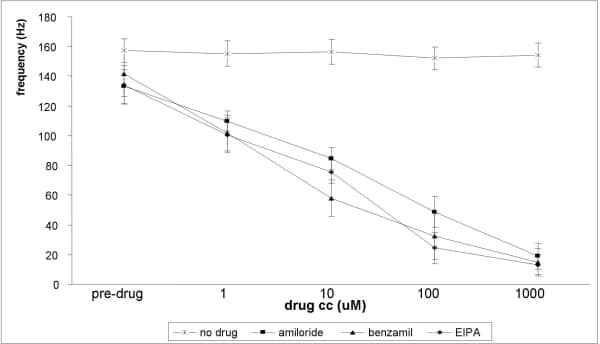Mechanotransduction is similar in a wide variety of primary mechanosensory nerve endings, with shear stress or membrane stretch opening mechanically gated cationic channels (Guharay & Sachs, 1984). However, the channel types involved are less clear. In mammals, mechanical gating of N- and L-type Ca2+ channels (Calabrese et al., 2002) and/or amiloride-sensitive epithelial Na+ channels (Achard et al., 1996) has been suggested. The brain sodium channel 1 (BNC1/BNaC1), from the degenerin/epithelial Na channel (DEG/ENaC) superfamily, is important in rapidly and slowly adapting mechanosensory organs (Price et al., 2000). However, little is known about the channels of many mammalian proprioceptors, including muscle spindles. Therefore, we investigated the effect of ENaC mechanosensitive channel inhibitors in rat muscle spindles by examining their sensitivity to amiloride and two homologues, benzamil and 5-(N-Ethyl-N-isopropyl) amiloride (EIPA). Adult Sprague-Dawley rats (male, 350-620g) were killed by Schedule 1 methods (Animal (Scientific Procedures) Act, 1986), both 4th lumbrical nerve-muscle preparations excised and placed in gassed (95%O2-5%CO2) Liley`s saline at room temperature. Spindle discharges in the nerve were recorded en passant with Ag wire electrodes, and spikes in the first 0.5 s of the “hold” phase of 1 mm stretch-and-hold cycles were counted. Data are expressed as mean frequency ± SE. Differences between the pre-drug control and with-drug mean firing frequencies were evaluated by paired t-test, with a significance threshold of P < 0.05. After pre-drug control recording, increasing concentrations of amiloride (n = 14), benzamil (n = 12) or EIPA (n = 13) were applied (1, 10, 100μM and 1mM). All three drugs progressively lowered the spike frequency (Fig. 1), producing significant inhibition at 1 μM (P < 0.03 for each). 1 mM drugs produced the most robust block, although none totally abolished firing (14.2%, 11.4% and 9.8% of controls for amiloride, benzamil & EIPA, respectively). No-drug control muscles showed no decrease in firing over the same time scale. These data indicate members of the degenerin/ENaC channel superfamily play a role in spindle mechanotransduction. In guinea pig airway low-threshold vagal afferents, benzamil is a more potent inhibitor than amiloride (Carr et al., 2001). In spindles, we find each drug is equipotent but inhibit at 100x lower (1 μM) concentrations. In conclusion, as in some other mammalian mechanosensitive endings, amiloride and its analogues inhibit afferent discharge in muscle spindles. However, spindle endings had much greater sensitivity and did not distinguish between the amiloride analogues.
University of Leeds (2008) Proc Physiol Soc 10, PC41
Poster Communications: Attenuation of stretch-activated discharge of rat muscle spindle afferents by ENaC channel inhibitors
A. Simon1, R. W. Banks2, G. S. Bewick1
1. School of Medical Sciences, Aberdeen University, Aberdeen, United Kingdom. 2. Biological and Biomedical Sciences, Durham University, Durham, United Kingdom.
View other abstracts by:
The effects of amiloride or its analogues on the firing rates of muscle-spindles in isolated preparations of lumbrical muscles of the rat.
Where applicable, experiments conform with Society ethical requirements.

